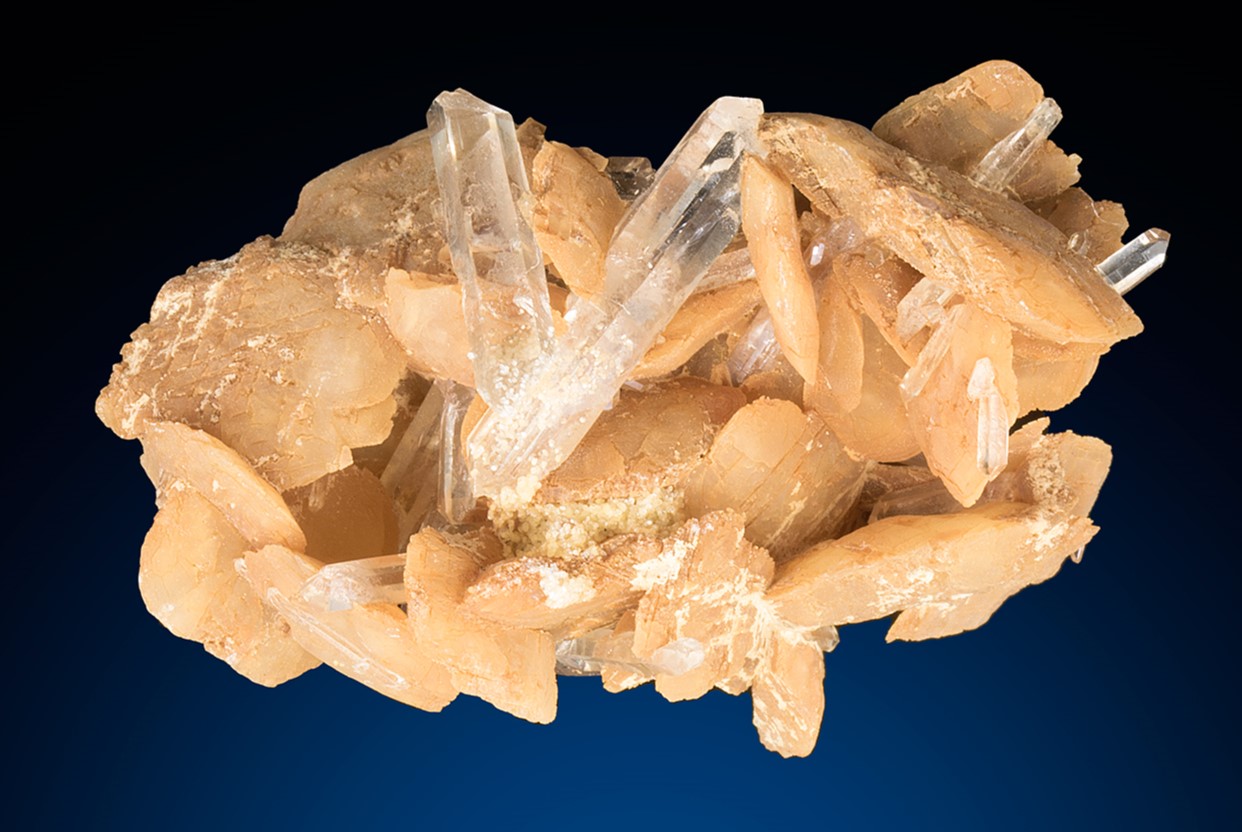
Have you ever wondered about the hidden treasures beneath our feet? Ankerite is one such gem, a mineral that tells a story of Earth's dynamic processes. With its unique blend of calcium, iron, magnesium, and manganese, ankerite stands out in the world of minerals. Found in hydrothermal veins and ancient iron formations, this mineral showcases a variety of colors, from pearly white to rusty brown. Its crystal structure, similar to dolomite and calcite, adds to its allure. Though not widely used industrially, ankerite's presence in geological studies is invaluable. Let's dive into 35 intriguing facts about this captivating mineral.
Key Takeaways:
- Ankerite is a unique mineral with a chemical formula Ca(Fe,Mg,Mn)(CO3)2. It forms in hydrothermal veins and is often associated with dolomite, calcite, and siderite.
- Ankerite has a hardness of 3.5 to 4 on the Mohs scale and exhibits various physical properties like color variations from white to brown, and a vitreous to pearly luster.
What is Ankerite?
Ankerite is a unique mineral that belongs to the rhombohedral carbonate group. Its chemical composition and physical properties make it a subject of interest for geologists and mineralogists alike. Let's dive into the fascinating world of ankerite with these 35 facts.
-
Chemical Formula
Ankerite's chemical formula is Ca(Fe,Mg,Mn)(CO3)2, indicating it contains calcium, iron, magnesium, and manganese. -
Crystal System
It crystallizes in the trigonal crystal system, also known as the rhombohedral system. -
Crystal Class
The crystal class of ankerite is rhombohedral (3), with a space group of R3. -
Unit Cell Parameters
The unit cell parameters for ankerite are a = 4.8312(2) Å and c = 16.1663(3) Å, with a unit cell volume of approximately 741.6 ų.
Where is Ankerite Found?
Ankerite can be found in various geological settings, often associated with other minerals. Its occurrence is widespread but specific to certain environments.
-
Occurrence
Commonly found in medium and low-temperature hydrothermal veins, ankerite is often associated with dolomite, calcite, siderite, and various sulphides. -
Composition
Ankerite is closely related to dolomite but differs by having magnesium replaced by varying amounts of iron(II) and manganese. It forms a series with dolomite and kutnohorite. -
Occurrence in Sediments
It occurs in sediments as authigenic, diagenetic minerals and as a product of hydrothermal deposition. It is also found in low-grade metamorphosed ironstones and sedimentary banded iron formations (BIF). -
Occurrence in Carbonatites
Ankerite is one of the minerals found in carbonatites, which are igneous rocks rich in carbonate minerals.
Physical Properties of Ankerite
Ankerite exhibits a range of physical properties that make it identifiable and distinguishable from other minerals.
-
Hardness
It has a hardness of 3.5 to 4 on the Mohs scale. -
Specific Gravity
The specific gravity ranges from 2.93 to 3.10 g/cm³. -
Cleavage
Ankerite has perfect cleavage on {1011}. -
Color
The color can vary from white, grey, brown, yellow, or reddish to yellowish brown. It often changes slowly when exposed to surface conditions, turning from pearly white to brown or rusty. -
Luster
Ankerite has a vitreous to pearly luster. -
Streak
The streak of ankerite is white. -
Transparency
Typically translucent to transparent in thin pieces, although it can be opaque in thicker specimens. -
Fracture
The fracture is subconchoidal to hackly, and the mineral is brittle.
Crystal Habits and Associations
Ankerite can form various crystal habits and is often found alongside other minerals.
-
Twinning
It often exhibits twinning, particularly on {0001}, {1010}, and {1120} planes. -
Crystal Habit
Ankerite can form rhombohedral crystals with curved faces, columnar, stalactitic, granular, and massive forms. -
Associated Minerals
Often associated with dolomite, siderite, baryte, quartz, fluorite, and ore minerals like tetrahedrite, chalcopyrite, and pyrite.
Industrial and Historical Significance
Though not widely used industrially, ankerite has historical significance and specific applications.
-
Industrial Uses
Limited industrial use, primarily in special construction or refractory materials. It was also used as a poor quality iron ore in countries lacking this metal or during difficult periods in history. -
Historical Significance
First recognized as a distinct species by Wilhelm von Haidinger in 1825 and named after Matthias Joseph Anker, an Austrian mineralogist.
Geological and Structural Insights
Understanding the geological and structural aspects of ankerite provides deeper insights into its formation and stability.
-
Geological Settings
Forms in various geological settings, including hydrothermal veins, metasomatic rocks, and low-temperature alteration of carbonates. -
Crystal Structure
Similar to dolomite and calcite, consisting of alternating layers of cations and [CO3] carbonate groups. The accommodation of metal atoms of different sizes leads to a small rotation of the CO3 groups around the threefold axis compared to calcite. -
Compressibility
Studies show that iron-rich ankerite exhibits a high degree of compressibility, essential for understanding its phase stability under different conditions. -
Phase Stability
DFT calculations indicate that pure CaFe(CO3)2 ankerite has never been found naturally or synthesized in a laboratory. -
Rietveld Refinement
Rietveld refinement of the ambient-conditions powder XRD pattern of iron-rich ankerite suggests specific atomic coordinates that align with calculated values and other literature results.
Optical and Chemical Properties
Ankerite's optical and chemical properties further distinguish it from other minerals.
-
Optical Properties
Exhibits uniaxial optical properties, with refractive indices ranging from nω = 1.690 to 1.750 and nε = 1.510 to 1.548. The birefringence is moderate, with a maximum value of δ = 0.180 to 0.202. -
Dispersion
Shows strong dispersion, a characteristic feature of many carbonate minerals. -
Fluorescence
Exhibits weak fluorescence, typically orange in color. -
Solubility
Soluble in acids, common among carbonate minerals. -
Magnetism and Radioactivity
Not magnetic and does not exhibit radioactivity.
Formation and Occurrence in Specific Environments
Ankerite forms in specific environments, often through unique geological processes.
-
Formation in Hydrothermal Veins
Forms in hydrothermal veins through the low-temperature alteration of carbonates. Often associated with dolomite, calcite, and siderite. -
Formation in Metasomatic Rocks
Can also form in metasomatic rocks, which have undergone chemical alteration due to interaction with fluids. -
Occurrence in Precambrian Iron Formations
A dominant carbonate in Precambrian iron formations, particularly in the "algoma" type ores. These formations are rich in iron and characterized by banded ironstones. -
Occurrence in Saliferous Marls
Found in saliferous marls, sedimentary rocks rich in salt and other minerals. Often associated with dolomite in these deposits.
Ankerite's Unique Role in Geology
Ankerite stands out as a unique mineral with its blend of calcium, iron, magnesium, and manganese carbonates. Found in hydrothermal veins, metasomatic rocks, and Precambrian iron formations, it showcases a variety of colors from white to reddish brown. Its trigonal crystal system and rhombohedral class give it distinct physical properties like a hardness of 3.5 to 4 on the Mohs scale and a specific gravity of 2.93 to 3.10 g/cm³. Though not widely used industrially, ankerite's historical significance as a poor-quality iron ore can't be overlooked. Its compressibility and phase stability are crucial for understanding geological processes. Whether found in carbonatites or saliferous marls, ankerite's presence helps geologists piece together Earth's history. This mineral, often mistaken for ferroan dolomite, remains a key player in the study of mineralogy and geology.
Frequently Asked Questions
Was this page helpful?
Our commitment to delivering trustworthy and engaging content is at the heart of what we do. Each fact on our site is contributed by real users like you, bringing a wealth of diverse insights and information. To ensure the highest standards of accuracy and reliability, our dedicated editors meticulously review each submission. This process guarantees that the facts we share are not only fascinating but also credible. Trust in our commitment to quality and authenticity as you explore and learn with us.


